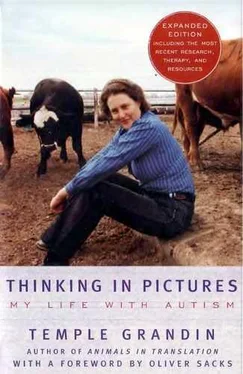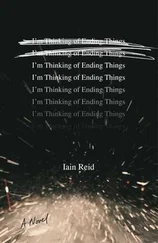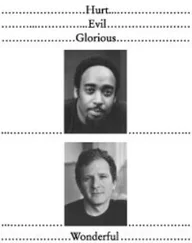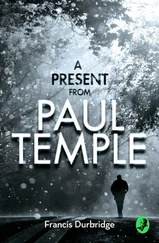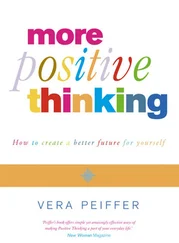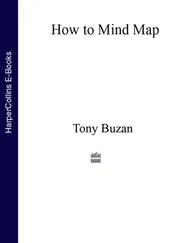We can also share, even if we cannot wholly understand, the extraordinary passion and understanding for cattle which consume Temple, and which have made her, by degrees, a world-renowned expert on cattle psychology and behavior, an inventor of devices and facilities for handling them, and a passionate advocate of their humane treatment. (Her original title for this book was A Cow's Eye View.) And we get a glimpse — this perhaps the least imaginable of all — of her total bewilderment about other people's minds, her inability to decipher their expressions and intentions, along with her determination to study them, study us, our alien behaviors, scientifically and systematically, as if (in her own words) she were «an anthropologist on Mars.»
We sense all this despite (or perhaps partly because of) the touching simplicity and ingenuousness of Temple's writing, her curious lack of either modesty or immodesty, her incapacity for evasion or artifice of any kind.
It is fascinating to compare Thinking in Pictures with Emergence. The intervening ten years have been years of increasing professional recognition and fulfillment for Temple — she travels, consults, lectures continually, and her devices are now used for cattle management and corrals all over the world — and of increasing authority too in the field of autism (half her lectures and publications are dedicated to this). Writing did not come easily to her at first, not because she lacked verbal facility, but because she lacked an imagination of other minds, of the fact that her listeners were different from her, were not privy to the experiences, the associations, the background information in her own mind. There were strange discontinuities (people injected suddenly into the narrative without warning, for instance); casual reference to incidents of which the reader had no knowledge; and sudden, perplexing changes of topic. It is said by cognitive psychologists that autistic people lack «theory of mind»—any direct perception or idea of other minds, or other states of mind — and that this lies at the heart of their difficulties. What is remarkable is that Temple, now in her fifth decade, has developed some genuine appreciation of other people and other minds, their sensibilities and idiosyncrasies, in the ten years which have passed since writing Emergence. And it is this which now shows itself in Thinking in Pictures, and lends it a warmth and color rarely seen in her earlier book.
Indeed, when I first met Temple, in August of 1993, I found her so «normal» at first (or so adept in simulating normality) that I had difficulty realizing that she was autistic — but during the course of a weekend together this was to come through in innumerable ways. When we went for a stroll she confessed that she had never been able to «get» Romeo and Juliet («I never knew what they were up to»), that she was stumped by complex human emotions of all sorts (of one man, a spiteful colleague, who tried to sabotage her work: «I had to learn to be suspicious, I had to learn it cognitively … I couldn't see the jealous look on his face»).
She spoke repeatedly of the android in «Star Trek,» Data, and how she identified with him as a «pure logical being»—but how, too, like him she was wistful about being human. But many sorts of humanness have become available for Temple in the past ten years. Not least among these is a capacity for humor and even subterfuge which one would have thought impossible in someone who is autistic. Thus, when she wanted to show me one of the plants she designed, she had me put on a hard hat and overalls («You look just like a sanitary engineer now!»), and smuggled me gleefully past the security guards.
I was struck by her rapport with, her great understanding of, cattle — the happy, loving look she wore when she was with them — and her great awkwardness, by contrast, in many human situations. I was also struck, when we walked together, by her seeming inability to feel some of the simplest emotions. «The mountains are pretty,» she said, «but they don't give me a special feeling, the feeling you seem to enjoy … You look at the brook, the flowers, I see what great pleasure you get out of it. I'm denied that.»
And I was awed, as we drove to the airport before my departure, by a sudden revelation of moral and spiritual depths which I had thought no autistic person would have. Temple was driving, when suddenly she faltered and wept, and said, «I don't want my thoughts to die with me. I want to have done something … I want to know that my life has meaning … I'm talking about things at the very core of my existence.»
Thus, in my brief (but very full) few days with Temple, I had a revelation of how, while in many ways so flat and constricted, her life was in other ways full of health, of depth, of deep human strivings.
Temple, now forty-seven, has never ceased to ponder and explore her own nature, which she feels is quintessentially concrete and visual (with the great strengths, and the weaknesses, which may go with this). She feels that «thinking in pictures» gives her a special rapport with cattle, and that her mode of thinking is, albeit at a much higher level, akin to their own mode of thinking — that she sees the world, in a sense, with a cow's eye. Thus though Temple often compares her own mind to a computer, she roots herself, and her own way of thought and feeling, in the creaturely and the organic. Her audacious chapters on sensation and autism, emotion and autism, relationships and autism, genius and autism, religion and autism, might seem strangely juxtaposed with her chapters on «connecting with animals,» and «understanding animal thought»—but for Temple, clearly, there is a continuum of experience extending from the animal to the spiritual, from the bovine to the transcendent.
Thinking in pictures, she feels, represents a mode of perception, of feeling and thought and being, which we may call «primitive» if we wish, but not «pathological.»
Temple does not romanticize autism, nor does she downplay how much her autism has cut her off from the social whirl, the pleasures, the rewards, the companionships, that for the rest of us may define much of life. But she has a strong, positive sense of her own being and worth, and how autism, paradoxically, may have contributed to this. At a recent lecture, she ended by saying, «If I could snap my fingers and be nonautistic, I would not — because then I wouldn't be me. Autism is part of who I am.» If Temple is profoundly different from most of us, she is no less human for being so, but, rather, human in another way. Thinking in Pictures is finally a study of identity, the «who-ness» no less than the «what-ness» of a most gifted autistic person. It is a deeply moving and fascinating book because it provides a bridge between our world and hers, and allows us a glimpse into a quite other sort of mind.
1
Thinking in Pictures
Autism and Visual Thought
I think in pictures. Words are like a second language to me. I translate both spoken and written words into full-color movies, complete with sound, which run like a VCR tape in my head. When somebody speaks to me, his words are instantly translated into pictures. Language-based thinkers often find this phenomenon difficult to understand, but in my job as an equipment designer for the livestock industry, visual thinking is a tremendous advantage.
Visual thinking has enabled me to build entire systems in my imagination. During my career I have designed all kinds of equipment, ranging from corrals for handling cattle on ranches to systems for handling cattle and hogs during veterinary procedures and slaughter. I have worked for many major livestock companies. In fact, one third of the cattle and hogs in the United States are handled in equipment I have designed. Some of the people I've worked for don't even know that their systems were designed by someone with autism. I value my ability to think visually, and I would never want to lose it.
Читать дальше
